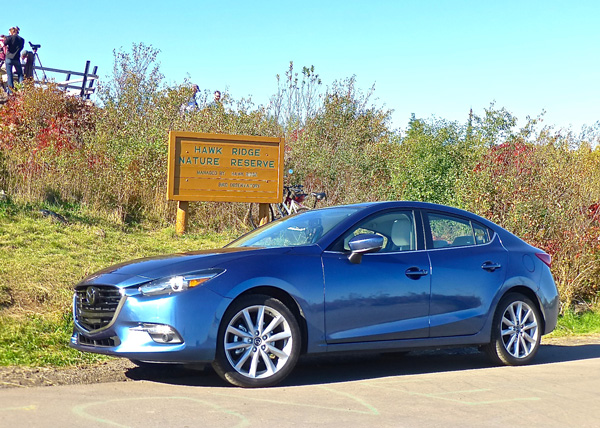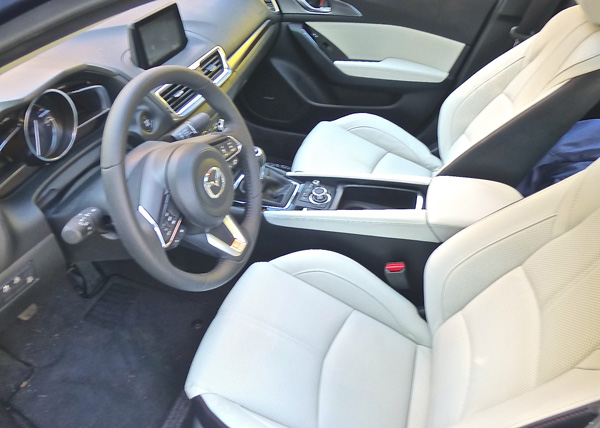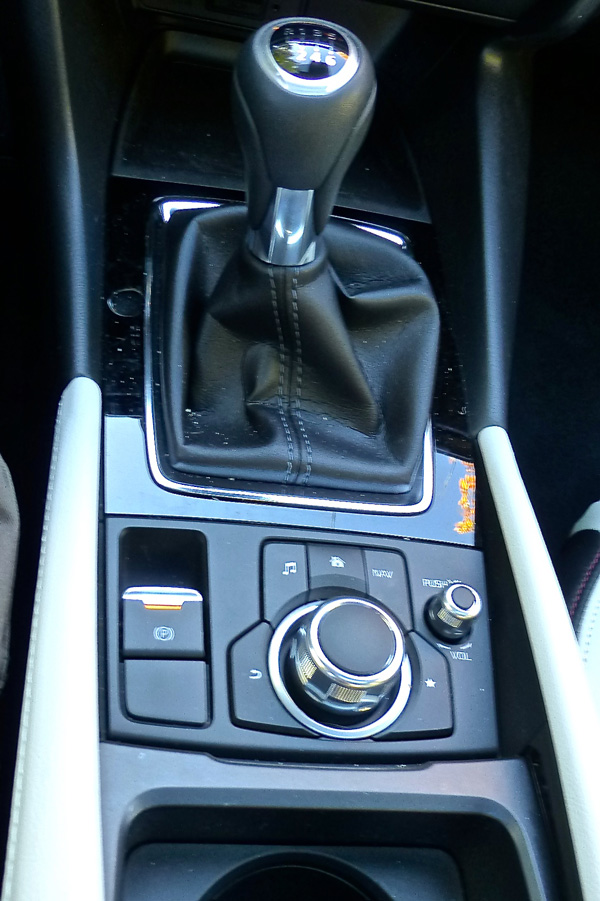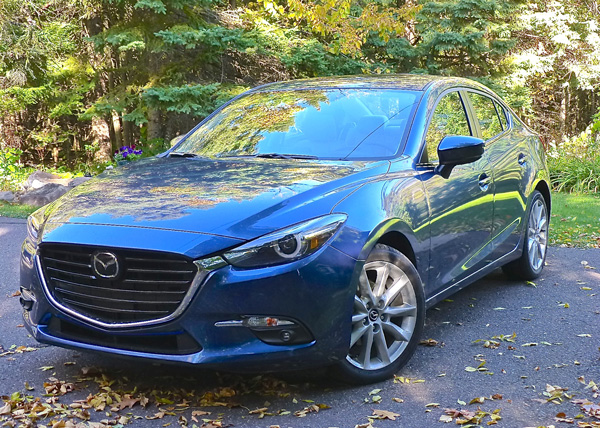News & Articles
Browse all content by date.

In the process of test-driving new cars, sometimes there are surprises and sometimes things just happen to break right. When I had the chance to drive a vehicle back from the Midwest Auto Media Association fall rally in the South Chicago suburb of Joliet, I welcomed the opportunity.
The vehicle would be a 2017 Mazda3, which is the compact vehicle Mazda made a decade or so ago that revolutionized the compact segment, forcing Honda to upgrade its Civic, Toyota to improve its Corolla, Nissan to improve its Sentra, and begin a trend that has led those compacts to replace midsize cars as the most popular.
The 2017 model I would be driving didn’t look a lot different than the current 2016 model, but it was a car that had just been delivered to the press fleet outlet I was working with, and there was something special about being the first media person in the world to get a chance to drive a new model.
The Mazda3 has always been a tightly built vehicle, with excellent handling and peppy performance, while delivering outstanding fuel economy. I’ve driven Mazda3 models every year, sometimes more than one, and ever since Mazda developed its technically brilliant Skyactive engine concept, with both the 2.0 and 2.3 4-cylinder engines getting the holistic treatment and both working in the Mazda3, it has been even better.
We cruised effortlessly from Chicago up through Wisconsin to Duluth, Minnesota, with only one post-breakfast stop, in Wisconsin Dells for spectacular popcorn. We got from 38 to 43 miles per gallon for the trip, more on the first part, in Chicago traffic strangely enough.

The extra sportiness I discovered was something I attributed to the fact that the test car had a 6-speed manual transmission. Almost a forgotten asset, I couldn’t remember the last time I drove a Mazda3 with a stick, but whenever you drive two identical cars, the one with a stick shift always feels sportier than the automatic. So I figured that’s why the new Mazda3 felt so special.

It handled every curve and every lane change as though it was linked to my psyche, almost anticipating my moves before I made them, which, in turn, made them all smooth and, as the saying goes, as though we were on rails.
The Mazda3 comes in sedan or hatchback, and the hatchback we drove is like a compact utility vehicle in a compact sedan body. It was quick and performed better than it looked, and it looked great! It has a slightly raised rear to house the hatchback and the roomy storage space underneath it.
Mazda, meanwhile, has been working for years to develop a new handling precision feature called G-vectoring. It is a fascinating result of some progressive thinking by Mazda engineers, who have long benefitted by the company’s small size and progressive thinking.
The Skyactive engine concept, which takes a new and unique method for building an engine from the ground up, combining all the latest technologies into an engine that over-achieves. For evidence, consider that usually an engine with more than 9-to-1 compression ratio normally requires premium fuel to avoid pinging or engine damage; the Skyactive engines have 13-to-1 compression and require regular. Now THAT’S engineering.

So I wanted to learn more about G-vectoring, which is designed to make the car respond much quicker and more accurately to driver input. It sounds like it would make a car sportier, but the intention is to make it safer, and more predictable.
Dave Coleman, a Mazda engineer, explained it. “We’ve studied how a car responds to driver input,” Coleman said. “Not necessarily for performance, but more as an interface between driver and car. A sense of intuition. We studied the differences of accelerating, braking, going uphill or downhill.”
Going downhill, with the weight on the front wheels, makes a car handle more critically. That translates to level roads, too. Making a sharp left turn, for example, means the driver anticipates, times it right, and turns the steering wheel. If it’s perfect, fine; if not, then the driver has to correct, and then possibly correct again to be heading in a straight vector.
Often the sequence is: turn, correct, then correct again because you’ve over-corrected, and finally you’re going straight. Better drivers need to correct less, and their passengers appreciate it, because they can’t anticipate what the driver is anticipating.
In exhaustive tests, using an electronic switch to activate or deactivate the system, Mazda proved that if the car’s power is lessened just slightly to the outside front wheel, just for an instant, the corner can be taken with far better precision. When a driver makes a sharp turn, he anticipates what’s coming and can brace his head; the passenger can’t anticipate it as well, and gets his or her head snapped around. Car sickness is made of such things.
With the system that will be installed on some 2017 Mazdas, and will expand to ultimately include all cars and SUVs in the Mazda lineup, there is no optional switch to control it. It simply works automatically, and – trust me on this – you won’t notice it.
“If you’re driving, you won’t even notice if the right front corner has its power decreased for an instant when the computer reads the g-forces and signals the change, but it makes the driver’s instinct to turn more precise,” said Coleman.
Pushing down on the outside front tire a bit, and cutting the power to it slightly, reduced the load on it. The tendency for that outside front corner to dip slightly feeds into the driver’s instincts for turning. The driver won’t notice the slightly reduced power, but only that the car handles with better precision.
As a skeptic, I said that I had just driven a new 2017 Mazda3 with a stick shift back from Chicago to Duluth, and then around Duluth with extensive hill climbs, particularly up to Hawk Ridge to watch some of the annual raptor flight from the bluff above the city’s east end, and I couldn’t imagine any car handling better than this Mazda3 already did. When I went around a turn hard, I never seemed to have to correct the steering, because it was so precise in the first place.
“That was a 2017 Mazda3?” Coleman asked me.
“Yes,” I answered. “They told me it hadn’t been driven and was brand new. But it handled fantastically, which I attributed to the fact it was a stick.”
“That car,” said Coleman, “was equipped with G-vectoring.”
Just like that, I’m a believer. My long-held theory about highway accidents is that many of them occur when a driver makes a sharp turn – to go around a curve or to swerve to miss a deer in the roadway – he oversteers and then must correct, and when he corrects, he tends to over-correct, possibly because of adrenaline, and is then out of control.

With the Mazda3, maybe that could happen. With the 2017 Mazda3 with G-vectoring, your first tendency to turn is read by the instant-acting computer which alters the outside front wheel’s downforce and power in the blink of an eye, and all you know is that you’ve made the turn so precisely that there is no correction. And thus, no overcorrection.
“We worked for a lot of years, but when we developed the Skyactive engines, and the transmissions, and computers, we’ve made it work,” Coleman said.
He added that the system will be seamlessly installed on the 2017 Mazda6 and Mazda3, and will migrate to also include the CX-3 and CX-5 crossover utility vehicles.
And if there was a perfect way to let me test the system and be caught totally off-guard by its success in making the car handle and feel better, and me feel like a better driver, putting me behind the wheel in the stick-shift Mazda3 for a week-long road test was the perfect surprise.
| Tweet |


